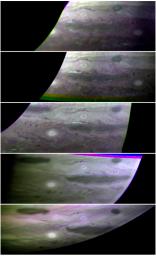Ammonia Ice Clouds on Jupiter
Caption:
The top cloud layer on Jupiter is thought to consist of ammonia ice, but most of that ammonia "hides" from spectrometers. It does not absorb light in the same way ammonia does. To many scientists, this implies that ammonia churned up from lower layers of the atmosphere "ages" in some way after it condenses, possibly by being covered with a photochemically generated hydrocarbon mixture. The New Horizons Linear Etalon Imaging Spectral Array (LEISA), the half of the Ralph instrument that is able to "see" in infrared wavelengths that are absorbed by ammonia ice, spotted these clouds and watched them evolve over five Jupiter days (about 40 Earth hours). In these images, spectroscopically identified fresh ammonia clouds are shown in bright blue. The largest cloud appeared as a localized source on day 1, intensified and broadened on day 2, became more diffuse on days 3 and 4, and disappeared on day 5. The diffusion seemed to follow the movement of a dark spot along the boundary of the oval region. Because the source of this ammonia lies deeper than the cloud, images like these can tell scientists much about the dynamics and heat conduction in Jupiter's lower atmosphere.
Cataloging Keywords:
| Name |
Value |
Additional Values |
| Target |
Jupiter |
|
| System |
Jupiter |
|
| Target Type |
Planet |
|
| Mission |
New Horizons |
|
| Instrument Host |
New Horizons |
|
| Host Type |
Flyby Spacecraft |
|
| Instrument |
Linear Etalon Imaging Spectral Array (LEISA) |
|
| Detector |
|
|
| Extra Keywords |
Ammonia, Atmosphere, Color, Infrared, Storm |
| Acquisition Date |
|
| Release Date |
2007-10-09 |
| Date in Caption |
|
|
| Image Credit |
NASA/Johns Hopkins University Applied Physics Laboratory/Southwest Research Institute |
| Source |
photojournal.jpl.nasa.gov/catalog/PIA10076 |
| Identifier |
PIA10076 |

